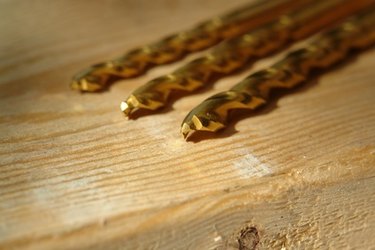Things You'll Need
Sanding block with coarse-grit sandpaper
Sanding block with medium-grit sandpaper
Sanding block with fine-grit sandpaper
Vacuum cleaner with hose attachment
Clean cloth
Paint thinner

When working with wood, there are many challenges that you may face. One of these challenges may involve trying to remove any roughness the wood may have. A rough wooden surface can catch on your clothing, give you splinters and present a less than satisfying appearance. Luckily, smoothing the surface of rough wood is easy and can be done quickly and efficiently when using the correct tools.
Step 1
Hold the sanding block with the coarse-grit sandpaper comfortably in your hand. Begin moving the sanding sponge in even, forward and backward strokes over the rough areas of the wood. Always follow the direction of the grain of the wood.
Video of the Day
Step 2
Repeat the sanding process using the medium-grit sanding block. Then, sand the wood using the sanding block with the fine-grit sandpaper.
Step 3
Clean the sanded particles away from the wood using the hose attachment of your vacuum cleaner. Dip your clean cloth into a can of paint thinner and rub the cloth across the wood. This removes the finer particles that the vacuum cleaner could not pick up. Finish the surface of the wood by applying a wood stain or your choice of finishes.
Tip
Alternatively, make your own sanding block by wrapping a sheet of sandpaper around a blackboard eraser and gluing down the edges.
Test the smoothness of the wood by rubbing a nylon stocking across the surface. If the stocking catches, the wood needs further sanding.
If you are sanding a wooden surface that features wood grain traveling in multiple directions, such as in inlaid wooden items, lay a strip of tape over the edge of the area of wood you are sanding. The tape serves as a border, preventing the sandpaper from damaging wood in conjoining areas.
Warning
Do not sand the wood with fine sandpaper prior to using the coarser grits. This removes the softer areas between the rings of the wooden surface, possibly producing a rippled effect on the wood.
When sanding flat surfaces, do not extend your sanding strokes too far past the edge of the wooden surface. This could cause the edge of your flat surface to become rounded.
Video of the Day